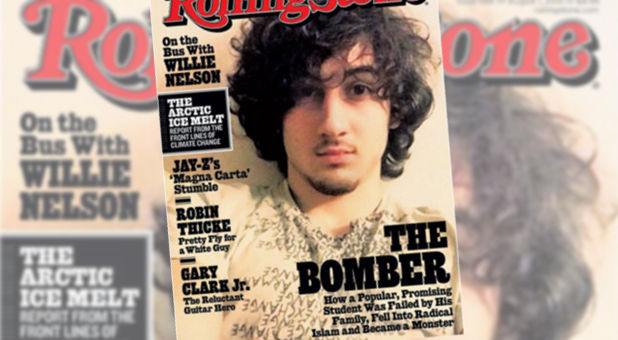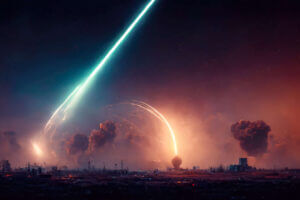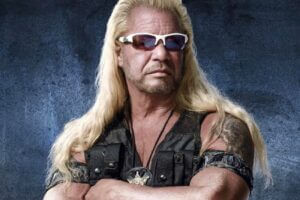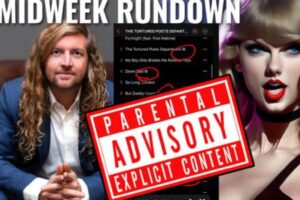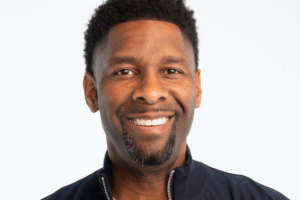Rolling Stone magazine is laughing all the way to the bank. The hipper-than-thou journal of the smart set is embroiled in a noisy controversy over the cover of its August issue. They’ve published a dreamy picture of young Dzhokhar Tsarnaev, the surviving brother accused of bombing the Boston Marathon. The cover shot is being compared to the stoned-looking cover the magazine ran on bad-boy rocker Jim Morrison decades ago.
Dzhokhar Tsarnaev is charged with a terrorist attack last April that claimed three lives—including that of an 8-year-old boy—and maimed dozens of innocent runners and bystanders. Editors of Rolling Stone deny they are glamorizing a terrorist. They say their in-depth reportage gives important clues as to how a seemingly agreeable teen was radicalized and became a jihadi.
A number of retail news outlets, and even CVS, plan not to carry this issue of the magazine because of its troubling image on the cover. Social media has erupted in outrage with friends of the wounded expressing their righteous indignation over the magazine cover.
We can’t really expect Rolling Stone editors to have read French philosopher La Rochefoucauld’s wise maxim: “To understand all is to pardon all.” And besides, Rolling Stone is following in famous journalists’ footsteps in profiling those credibly accused of mass murder.
Time magazine editors faced similar criticisms back in the 1930s and ’40s. That’s when the mass circulation newsweekly put Germany’s Adolf Hitler and the Soviet Union’s Josef Stalin on their cover. They even named the 20th century’s greatest mass killers “Man of the Year” on separate occasions. Nazi Germany’s führer, Hitler, gained that designation in 1938. Stalin received the distinction in 1943.
Time‘s editors also pushed back against critics in their decade. “We are not honoring these people,” they argued. “We are simply saying that the ‘Man of the Year’ is that one person who did more, for good or ill, to influence the course of events. This is Time marching on,” they seemed to say, “not Good Housekeeping.”
We know this much about Hitler and Stalin: By the time they were nominated as Time‘s “Man of the Year,” they were both far along in their careers of mass murder.
Did Time‘s editors know that when they so designated the despots? Yes. They could not not know it. Of course, Time readers knew about Hitler’s “Night of the Long Knives,” which took place on June 30, 1934. That’s when Hitler lashed out at his opponents—right-wing generals, Catholic Center party members, as well as his now inconveniently fanatical supporters.
Hitler used the occasion of a purge of his own ranks to kill Storm Trooper leader Ernst Roehm, a very possible rival for Hitler’s power. Roehm was seized in a bed he was sharing with a teenage boy.
Time chose to name Hitler “Man of the Year” for 1938. That fateful year, the führer had triumphed over the weak-kneed leaders of the Western democracies—Britain’s Prime Minister Neville Chamberlain and France’s Edouard Daladier-at Munich. He browbeat them into accepting his almost bloodless takeover of Czechoslovakia’s crucial Sudetenland region. Most significant, however, was the fact that Germany had erupted into a nationwide orgy of anti-Semitic murders and rioting on the night of November 9-10, 1938. That darkest night yet of Nazi rule would be known to history as Kristallnacht, the Night of Broken Glass.
Time editors knew all this when they named Adolf Hitler “Man of the Year” for 1938.
About Josef Stalin, information was admittedly harder to come by. The Soviet Union was not an open society. It didn’t pay for Western journalists to ask too many questions. Actually, it paid very well for Western journalists, like The New York Times‘ Walter Duranty, not to question Stalin at all. Duranty won a Pulitzer Prize for his coverage of Stalin’s industrialization and forced collectivization policies. Between the lines, it was clear that things weren’t going well for the kulaks (fists). This Stalinist word meant “grasping, greedy peasants.”
We now know that 5 million of these people—who grasped only for a crust of bread—were intentionally starved to death in Ukraine under Stalin’s communist rule. “How long are you going to keep killing people in the Western Ukraine?” Britain’s Lady Astor asked Stalin in the Kremlin. His apparatchiks all froze in terror at the American-born Member of Parliament’s boldness. Puffing thoughtfully on his pipe, the “Father of the Progressive Peoples” mildly retorted, “As long as it is necessary.”
Time editors knew all this, too, when they named Stalin their 1943 “Man of the Year.”
So, will Time nominate Dzhokhar Tsarnaev their 2013 “Person of the Year”? Rolling Stone, in effect, has already scooped them.
The key to all of our efforts to understand the motives of great criminals may have been given to us before Hitler, Stalin or even Tsarnaev ever drew a breath. In 19th-century Russia, novelist Fyodor Dostoevsky wrote Crime and Punishment. In it, a hungry former university student in Petersburg, one Rodion Romanovich Raskolnikov, realizes that even the great conqueror Napoleon had to start somewhere on the trail of gloire and gore. Young Raskolnikov rationalizes that he should kill a grasping, greedy pawnbroker, an old woman. He has a right to do it, he fantasizes, for he is an extraordinary man.
“I simply hinted that the extraordinary man has the right … that it is not an official right but an inner right to decide in his own conscience to overstep certain obstacles and only in case it is essential for the practical fulfillment of his idea (sometimes, perhaps, of the benefit of the whole humanity). … In short, I maintain that all great men or even men a little out of the common, that is to say capable of giving [mankind] some new word, must from their nature be criminals, more or less, of course. Otherwise, it is hard for them to get out of the common rut.”
It’s all there in Raskolnikov in Dostoevsky’s Crime and Punishment, written 160 years ago.
What are we supposed to learn from Rolling Stone today—or Time in 1938 and 1943—that we couldn’t have learned from the great Russian novelist? And why must we keep learning these lessons year after year?
Bob Morrison is senior fellow for policy studies at Family Research Council. This article appeared in The Christian Post Wednesday.
See an error in this article?
To contact us or to submit an article


